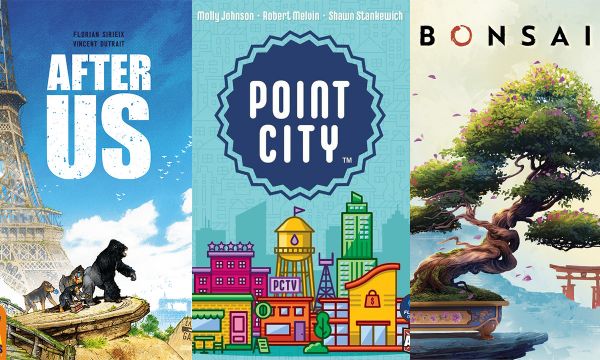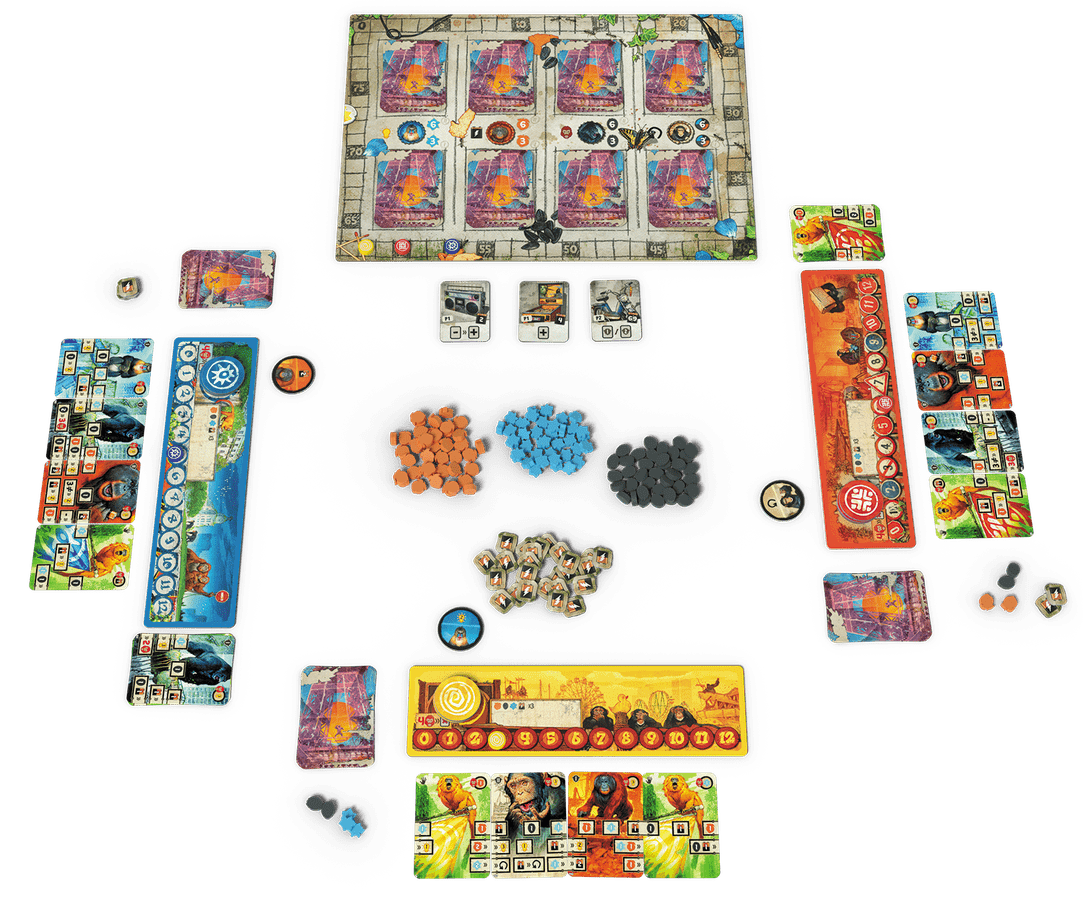Rapid Reviews: After Us, Point City, and Bonsai

With the summer convention season coming to a close, many new games have crossed our radar recently. Among the notable releases, After Us stands out as a post-apocalyptic deck-building and management game that challenges players to lead ape tribes in a nature-reclaimed world. Point City, a sequel to the beloved Point Salad, offers a quick and accessible experience, tasking players with constructing buildings on a shared grid to score points and secure resource bonuses. In contrast, Bonsai offers a serene yet competitive journey, inviting players to cultivate their own bonsai trees while strategically placing tiles and aiming for shared objectives. These intriguing games present a range of captivating mechanics and narratives, catering to diverse gaming preferences and leaving players eager to explore their intricacies.

After Us
1-6 players | ages 12+ | 40-60 minutes
Designed by Florian Sirieix
Published by Pandasaurus Games
Fans of deck building, management, and culling will find plenty to enjoy in After Us. Based in a near future where mankind is extinct and nature is reclaiming the planet, each player will take on the ape tribes looking to combo cards to gain resources, recruit new apes, and race to be the first to 80 victory points. Players will begin with eight Tamarins in their hand, drawing four and arranging them to close frames on these cards as best as possible. The first rows gain players resources, with the second and third rows offering bonuses (more resources or points) based on ensuring the frames are closed. Not all frames can be closed, so strategy is a must in determining what players want to accomplish immediately and long term.
After cards have been arranged and resources and points gathered, players will have the option to use one of four action discs to decide if they want to recruit level 1 or level 2 orangutans, mandrills, chimpanzees, or gorillas. Each ape has a different benefit, with mandrills being keen to help players gain points and gorillas adept at building rage, which allows players to cull cards from their decks. Using the action disc to gain apes also allows for an action bonus, and any gained apes are placed on top of the draw pile for immediate use. Cards just used are placed in a discard pile, and four new cards are drawn to repeat the process until a player reaches the 80 points threshold. Play wraps up and the player with the most points after the round is completed is the winner.
A quick game that escalates as players begin to develop their engine and understand how to best maximize turns, After Us is a zippy game with easy rules and an easier goal. Yet, with such a fun engine-building mechanism of lining up cards to close frames to hoard resources, it feels like After Us is wasted as a race toward 80 points. Some ape cards, particularly gorillas and mandrills, are also more powerful (even at level 1) than orangutans and chimpanzees, so players will often load up on them to cull cards and ramp up the race toward points. The solo mode is also far more challenging than multiplayer, though it is notable the game is great for that 2-6 player count and that versatility is what makes it worth a look. It also seems After Us is ripe for an expansion that ramps up the difficulty and variability, but in its current iteration, it is a solid game in any collection that looks to service a wide player count.

Point City
1-4 players | ages 10+ | 15-30 minutes
Designed by Molly Johnson, Robert Melvin & Shawn Stankewich
Published by Flatout Games / AEG
The sequel of the designing trio’s Point Salad, Point City is a quick and easy game in which players are gathering resources to construct buildings all in the same 4-by-4 grid. Players may take up to two orthogonal cards from any row or column, with resources going into one’s hands or being spent immediately to construct a building. If players take building cards, they must be able to complete them on that turn. The grid is then refilled by the opposite side of the cards just taken (for example, if a player has taken a building card and then a resource card directly beneath it, they will replace the building card with the resource side from the draw pile and the resource card with the building card side from the draw pile).
Turns are quick and easy, all with the goal of trying to construct buildings that will earn you points but also provide permanent resource bonuses so that the game scales up fast. There are also Civic buildings, which offer players the chance to claim one of the Civic tokens on display. Civic tokens award end-of-game points based on specific conditions, such as 3 points for every pair of buildings with the shown resources or just 7 points without conditions at game’s end.
Once the draw deck has been depleted, the game ends. Players will add up the total of completed buildings and points earned from Civic tokens, with the highest total being the winning player.
Point City has much in common with the Splendors and Machi Koros of the gaming world, but the speed and simplicity in which the game is executed is much faster and more elegant than those similar titles. This is the perfect game to break out with new gamers or family and friends around a dinner table because it’s a small package and can be played quickly over and over.

Bonsai
1-4 players | ages 8+ | 40 minutes
Designed by Rosaria Battiato, Massimo Borzì, Martino Chiacchiera
Published by dV Games
This chilled-out puzzler is for those looking for a competitive, but not fierce, experience. Everyone is trying to build out their own bonsai trees and this is done through two simple actions: Meditate or Cultivate. Meditate allows players to gain one of four cards from the shared market, as well as any tiles (bark, leaves, flowers, and fruits) shown in that spot. When players Cultivate, they place tiles onto their bonsai tree, being mindful of the placement rules. These include leaves touching bark, flowers touching leaves, and fruit being in between two adjacent leaves. There are limitations to what you can place and how many during each Cultivation action, but the total of tiles as well as the type are increased as players take cards, gaining them tiles or tool cards, which provide bonuses to how many tiles can be played upon one’s bonsai tree. Other cards gain players the ability to take extra tiles immediately, play extra tiles immediately, or provide additional scoring bonuses at the end of the game. Players will also be building their bonsai with an eye toward shared goals as well as inherent points gained from flowers, leaves, and fruit placements. Once the last card has been drawn from the draw pile, the game ends and players add their totals, and the player with the highest total is declared the winner.
Bonsai is so elegantly simple and engaging. The player interaction is minimal, down to who claims what cards during a turn, but this keeps the game breezy and at the level of interaction it should be. Bonsai is meant to mimic the meditative experience of maintaining one’s own bonsai, encouraging players to build differently and seek alternate paths to points. The solo variation is also soothing and has a nice variation that makes decisions when taking the Meditate action more thoughtful. At its price point (MSRP of $35), this is a great addition to the collection for fans of Cascadia, Calico, Evergreen, and Azul.
Disclosure: We received advance review copies of After Us and Point City to write these reviews.




